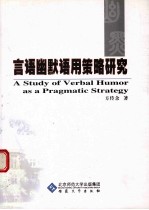

言语幽默语用策略研究PDF电子书下载
- 电子书积分:10 积分如何计算积分?
- 作 者:方传余著
- 出 版 社:合肥:安徽大学出版社
- 出版年份:2010
- ISBN:9787811108644
- 页数:212 页
1 Introduction 1
1.1 Preamble 1
1.2 Rationale of the study 2
1.3 Objectives of the study 5
1.4 Scope of the study 6
1.5 Methodology and data collection 10
1.6 Organization of the study 11
2 Study of Humor and Pragmatic Strategy:An Overview 14
2.1 Study of humor 15
2.1.1 Disagreement on humor and humor study 15
2.1.2 Social-psychological theories of humor 20
2.1.2.1 Relief theories 21
2.1.2.2 Superiority theories 22
2.1.2.3 Incongruity theories 23
2.1.3 Linguistic theories of humor 26
2.1.3.1 Semantic script theory of humor 27
2.1.3.2 General theory of verbal humor 28
2.1.3.3 Audience-based theory of verbal humor 30
2.1.4 Other prevalent approaches to humor 31
2.1.4.1 Pragmatic approaches 31
2.1.4.2 Cognitive-linguistic approaches 40
2.1.4.3 Chinese scholars on humor 41
2.2 Study of pragmatic strategy 42
2.2.1 Pragmatic theories and pragmatic strategy 42
2.2.2 Sporadic studies of pragmatic strategy 44
2.3 Summary 46
3 Humor in Communication 48
3.1 Basic notions related to humor in communication 49
3.1.1 Humor and laughter 49
3.1.2 Sense of humor 53
3.1.3 Joke similarity and variation 58
3.1.3.1 Joke similarity 59
3.1.3.2 Joke variation 62
3.1.4 Canned jokes and spontaneous humor 68
3.1.4.1 Canned jokes in communication 69
3.1.4.2 Transferability between canned jokes and spontaneous humor 73
3.2 Humor as a communication mode 76
3.2.1 Serious and humorous modes of communication 76
3.2.1.1 Serious mode of communication 76
3.2.1.2 Humorous mode of communication 79
3.2.2 Mode-switching in communication 84
3.3 Summary 91
4 Joke Teller's Strategies 93
4.1 Macro-strategies 95
4.1.1 Script 96
4.1.2 Script overlap 101
4.1.3 Script oppositeness 104
4.2 Micro-strategies 109
4.2.1 Orthographic strategy 112
4.2.2 Phonological strategy 116
4.2.3 Lexical strategy 120
4.2.4 Syntactic strategy 125
4.2.5 Discourse strategy 128
4.3 Summary 131
5 Interlocutor's Strategies 134
5.1 Interlocutor as humor producer 135
5.2 Macro-strategies 139
5.2.1 CP-related strategies 139
5.2.2 PP-related strategies 145
5.2.3 Speech-act-related strategies 154
5.3 Micro-strategies 161
5.3.1 Presupposition-related strategies 161
5.3.2 Deixis-related strategies 166
5.4 Summary 171
6 Signaling Strategies and Responding Strategies 173
6.1 Signaling strategies 174
6.2 Responding strategies 178
6.2.1 Nonverbal responses 179
6.2.2 Verbal responses 181
6.2.3 Lack of response 183
6.2.4 Implicatures of responding strategies 185
6.3 Summary 187
7 Conclusion 189
7.1 Major findings of the study 190
7.2 Implications of the study 192
7.3 Limitations of the study 195
7.4 Suggestions for further study 196
Bibliography 198
- 《红色旅游的社会效应研究》吴春焕著 2019
- 《汉语词汇知识与习得研究》邢红兵主编 2019
- 《生物质甘油共气化制氢基础研究》赵丽霞 2019
- 《东北民歌文化研究及艺术探析》(中国)杨清波 2019
- 《联吡啶基钌光敏染料的结构与性能的理论研究》李明霞 2019
- 《异质性条件下技术创新最优市场结构研究 以中国高技术产业为例》千慧雄 2019
- 《《国语》和《战国策》词汇比较研究》陈长书著 2017
- 《中国制造业绿色供应链发展研究报告》中国电子信息产业发展研究院 2019
- 《信息系统安全技术管理策略 信息安全经济学视角》赵柳榕著 2020
- 《行政保留研究》门中敬著 2019
- 《人工智能概论》张广渊,周风余著 2019
- 《历史的转型 紫禁城的人文思考》吴士余著 2012
- 《最真实的汉朝》汤余著 2013
- 《首善 我的慈善谁做主 长篇小说》徐余著 2014
- 《新生代作家小说精选大系 为幸福的影子而奔走》许多余著 2014
- 《余味 吴俊余的小修行和私旅行》吴俊余著 2013
- 《打造企业特种兵》陶柏余著 2013
- 《观察与等待 在影像中感悟风景 全新版》耿兴余著 2013
- 《咽喉疾病内镜诊断与鉴别诊断》黄定强,梁传余主编 2013
- 《实用猪病防治技术》沈强,卫秀余著 2012
- 《大学计算机实验指导及习题解答》曹成志,宋长龙 2019
- 《大学生心理健康与人生发展》王琳责任编辑;(中国)肖宇 2019
- 《大学英语四级考试全真试题 标准模拟 四级》汪开虎主编 2012
- 《大学英语教学的跨文化交际视角研究与创新发展》许丽云,刘枫,尚利明著 2020
- 《复旦大学新闻学院教授学术丛书 新闻实务随想录》刘海贵 2019
- 《大学英语综合教程 1》王佃春,骆敏主编 2015
- 《大学物理简明教程 下 第2版》施卫主编 2020
- 《大学化学实验》李爱勤,侯学会主编 2016
- 《中国十大出版家》王震,贺越明著 1991
- 《近代民营出版机构的英语函授教育 以“商务、中华、开明”函授学校为个案 1915年-1946年版》丁伟 2017
